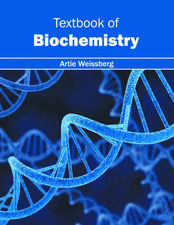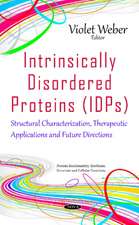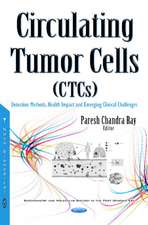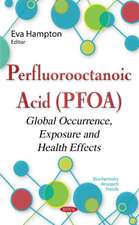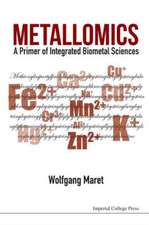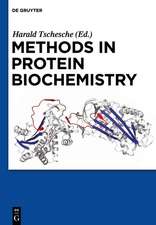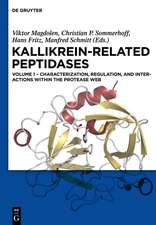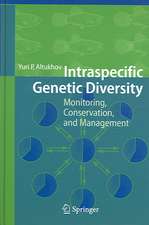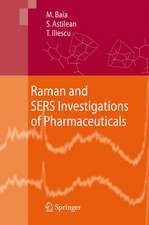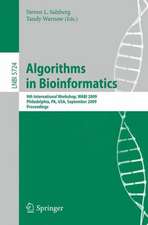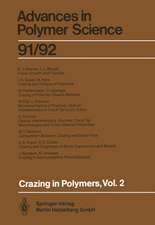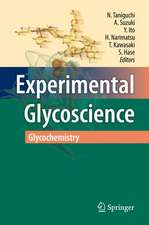Advances in Comparative and Environmental Physiology: Electrogenic Cl? Transporters in Biological Membranes Volume 19: Advances in Comparative and Environmental Physiology, cartea 19
G.A. Gerencser Contribuţii de G.A. Ahearn, P.A.V. Anderson, K.L. Blair, M.A. Cattey, X.B. Chang, J.G. Forte, A.F.X. Goldberg, D. Gradmann, J.W. Hanrahan, M. Hara, C. Inagaki, M. Inoue, J.K. Lanyi, D.F. Moffett, W.W. Reenstra, J.R. Riordan, D. Sanders, J.A. Tabcharani, J.F. White, A. Wolf, B. Zeleznaen Limba Engleză Paperback – 30 dec 2011
Din seria Advances in Comparative and Environmental Physiology
- 15%
 Preț: 644.63 lei
Preț: 644.63 lei - 15%
 Preț: 643.99 lei
Preț: 643.99 lei - 18%
 Preț: 1384.56 lei
Preț: 1384.56 lei - 15%
 Preț: 639.59 lei
Preț: 639.59 lei - 5%
 Preț: 725.79 lei
Preț: 725.79 lei - 15%
 Preț: 641.85 lei
Preț: 641.85 lei - 15%
 Preț: 634.68 lei
Preț: 634.68 lei - 15%
 Preț: 639.25 lei
Preț: 639.25 lei - 15%
 Preț: 638.76 lei
Preț: 638.76 lei -
 Preț: 392.75 lei
Preț: 392.75 lei - 15%
 Preț: 588.65 lei
Preț: 588.65 lei - 15%
 Preț: 640.71 lei
Preț: 640.71 lei - 15%
 Preț: 641.38 lei
Preț: 641.38 lei - 15%
 Preț: 639.08 lei
Preț: 639.08 lei - 15%
 Preț: 640.06 lei
Preț: 640.06 lei - 5%
 Preț: 712.46 lei
Preț: 712.46 lei - 5%
 Preț: 1092.99 lei
Preț: 1092.99 lei - 15%
 Preț: 646.94 lei
Preț: 646.94 lei - 15%
 Preț: 651.34 lei
Preț: 651.34 lei - 15%
 Preț: 640.06 lei
Preț: 640.06 lei - 15%
 Preț: 649.71 lei
Preț: 649.71 lei - 15%
 Preț: 638.57 lei
Preț: 638.57 lei - 15%
 Preț: 634.49 lei
Preț: 634.49 lei - 15%
 Preț: 640.71 lei
Preț: 640.71 lei
Preț: 639.73 lei
Preț vechi: 752.63 lei
-15% Nou
Puncte Express: 960
Preț estimativ în valută:
122.43€ • 127.34$ • 101.07£
122.43€ • 127.34$ • 101.07£
Carte tipărită la comandă
Livrare economică 14-28 aprilie
Preluare comenzi: 021 569.72.76
Specificații
ISBN-13: 9783642782633
ISBN-10: 3642782639
Pagini: 280
Ilustrații: XII, 264 p.
Dimensiuni: 155 x 235 x 15 mm
Greutate: 0.4 kg
Ediția:Softcover reprint of the original 1st ed. 1994
Editura: Springer Berlin, Heidelberg
Colecția Springer
Seria Advances in Comparative and Environmental Physiology
Locul publicării:Berlin, Heidelberg, Germany
ISBN-10: 3642782639
Pagini: 280
Ilustrații: XII, 264 p.
Dimensiuni: 155 x 235 x 15 mm
Greutate: 0.4 kg
Ediția:Softcover reprint of the original 1st ed. 1994
Editura: Springer Berlin, Heidelberg
Colecția Springer
Seria Advances in Comparative and Environmental Physiology
Locul publicării:Berlin, Heidelberg, Germany
Public țintă
ResearchCuprins
1 Halorhodopsin: A Prokaryotic Light-Driven Active Chloride Transport System.- 1 Introduction.- 2 Anion Binding and the Retinal Chromophore as Reporter Group.- 3 The Photocycle.- 4 Light-Dependent Retinal Isomerizations and Schiff Base Deprotonation.- 5 Hypotheses of the Transport Mechanism.- References.- 2 Chloride ATPase in Marine Algae.- 1 Introduction.- 2 Objects.- 3 Some Conditions.- 4 Basic Observations: The Pump and Its Transportée.- 5 Fueling Substrate.- 6 Electrical Properties.- 7 Biochemical Approaches.- 8 Conclusions and Speculations.- References.- 3 Existence of a Chloride Pump in Molluscs.- 1 Introduction.- 2 Electrical Characteristics of Aplysia Gut.- 3 Biochemistry of the Cl? Pump.- 4 Sulfhydryl Ligands of the Cl? Pump.- 5 Reconstitution of the Cl? Pump.- 6 Molecular Weight and Reaction Sequence of the Cl? Pump.- 7 Conclusions.- References.- 4 Transporting Cl?-ATPase in Rat Brain.- 1 Introduction.- 2 Cl?-Stimulated ATPase in Mammalian Brain.- 3 Functional Significance of Cl? Pump in the Brain.- 4 Conclusions.- References.- 5 Proton-Coupled Chloride Transport in Plant Cells.- 1 Introduction.- 2 Evidence for Gradient-Coupled Cl? Transport.- 3 Kinetic Properties of Gradient-Coupled Cl? Transport at the Plasma Membrane.- 4 Conclusions and Future Prospects.- References.- 6 Electrogenic Coupling of Sulfate Secretion to Chloride Transport in Lobster Hepatopancreas.- 1 Introduction.- 2 Vertebrate Sulfate Transport Mechanisms.- 3 Transmembrane SO4/C1 Exchange in Vertebrate Epithelia.- 4 Transmembrane Sulfate Antiport in Hepatopancreatic Epithelium.- 5 Transcellular Sulfate Transport in Lobster Hepatopancreas.- References.- 7 Chloride Currents in Lower Organisms.- 1 Introduction.- 2 Protists.- 3 Porifera.- 4 Cnidaria.- 5 Platyhelminths.- 6Nematodes.- 7 Discussion.- References.- 8 Chloride Channels in Molluscs.- 1. Introduction.- 2. Excitable Cell Cl? Channels.- 3. Aplysia Gut Absorptive Cells.- References.- 9 Chloride Channels in Insects: A Search for Common Grounds.- 1 Introduction.- 2 Defining Characteristics of Vertebrate Epithelial Cl? Channels.- 3 Cl? Channels in Insect Epithelial Secretion and Absorption.- 4 GABA-Activated Cl? Channel in Nervous System and Muscle.- 5 Conclusions.- References.- 10 The Voltage-Gated Cl? Channel of Torpedo Electroplax: an Emerging View of its Structure and Function.- 1 Introduction.- 2 Electrocyte Physiology.- 3 Biophysics of the Cl? Channel.- 4 Biochemical Studies.- 5 Molecular Genetics of the Cl? Channel.- 6 Conclusion.- References.- 11 A Secretory Cl Channel from Epithelial Cells Studied in Heterologous Expression Systems.- 1 Introduction.- 2 Channels Implicated in Transepithelial Chloride Secretion.- 3 CFTR Expression and Reconstitution Generate the Low-Conductance Cl Channel.- 4 Properties of the CFTR Pore.- 5 Regulation of the CFTR Channel by Phosphorylation.- 6 Regulation of CFTR Channel by Nucleotides.- 7 Homologs from Other Species: Shark CFTR is also a Cl Channel.- 8 Conclusions.- References.- 12 Chloride Channels in Epithelial Cells of Intestine.- 1 Introduction.- 2 Small Intestine.- 3 Colon.- 4 Summary.- References.- 13 Chloride Transport by Gastric Mucosa.- 1 Introduction.- 2 Acidic and Nonacidic Cl? Secretion.- 3 Identification and Localization of Ion Transport Pathways.- 4 Localization of Passive Ion Transporters.- References.






